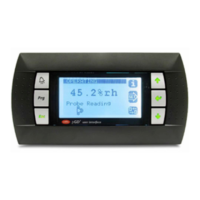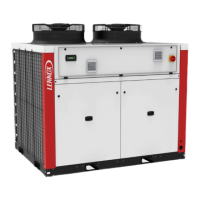Installation - Operation - Maintenance manual (IOM) • AIR COOLED CHILLERS & SPLIT UNITS - 1106-E • 11 •
If the external water pipes are in an area, where the ambient temperature is likely to fall below 0°C, insulate
the piping and add an electric heater. As an option, the internal unit piping is protected.
Ensure full earthling continuity
For unit with shell and tube heat exchangers, a drainage plug is located at the base of the evaporator. A drainage
pipe may be connected to this to enable drainage of evaporator water for service operations or for seasonal shut
down.
The use of a water filter in the water circuit upstream of the heat exchanger is mandatory. This filter must remove all
particles with a diameter greater than 1 mm, and must be positioned within 1 meter of the inlet of the exchanger. It
may be supplied as an option by the manufacturer. This filter will prevent the plate heat exchanger from clogging.
LACK OF FILTER AT THE INLET OF A PLATE HEAT EXCHANGER WILL MAKE WARRANTY VOID.
Hydraulic drawings in Annexes page 50 to 54, or supplied with the unit.
CHARGING AND REMOVING HEAT EXCHANGE FLUIDS SHOULD BE DONE BY QUALIFIED TECHNICIANS WITH
DEVICES THAT MUST BE INCLUDED ON THE WATER CIRCUIT BY THE INSTALLER. NEVER USE THE UNIT
HEAT EXCHANGERS TO ADD HEAT EXCHANGE FLUID.
3.4.2 - Water analysis
The water must be analysed; the water circuit installed must include all items necessary for treatment of the water:
filters, additives, intermediate exchangers, bleed valves, vents, isolating valves etc... according to the results of the
analysis.
We do not advise operation of the units with open loops which can cause problems with oxygenation, nor
operation with untreated ground water
.
Use of untreated or improperly treated water can cause deposits of scale, algae and sludge or cause corrosion and
erosion. It is advisable to call in a qualified water treatment specialist to determine what kind of treatment will be
necessary. The manufacturer cannot accept liability for damage caused by the use of untreated or improperly treated
water, salt water or brine.
Here are our non exhaustive recommendations given as an indication:
No NH4+ ammonium ions in the water, they are very detrimental for copper. <10mg/l
Cl- Chloride ions are detrimental for copper with a risk of perforations by corrosion by puncture. < 10 mg/l.
SO42- sulphate ions can cause perforating corrosion.< 30 mg/l.
No fluoride ions (<0.1 mg/l).
No Fe2+ and Fe3+ ions with dissolved oxygen. Dissolved iron < 5 mg/l with dissolved oxygen < 5 mg/l. Over
those values, it means a corrosion of steel which may generate a corrosion of copper parts under deposite of
Fe – this is mainly the case with shell and tube heat exchangers.
Dissolved silicon: silicon is an acid element of water and can also lead to corrosion risks. Content < 1mg/l.
Water hardness: TH >2.8 K. Values between 10 and 25 can be recommended. This will facilitate scale deposit
that can limit corrosion of copper. TH values that are too high can cause piping blockage over time.
TAC< 100.
Dissolved oxygen: Any sudden change in water oxygenation conditions must be avoided. It is as detrimental to
deoxygenate the water by mixing it with inert gas as it is to over-oxygenate it by mixing it with pure oxygen. The
disturbance of the oxygenation conditions encourages destabilisation of copper hydroxides and enlargement of
particles.
Specific resistance – electric conductivity: the higher the specific resistance, the slower the corrosion tendency.
Values above 3000 Ohm/cm are desirable. A neutral environment favours maximum specific resistance values.
For electric conductivity values in the order of 200-6000 S/cm can be recommended.
pH: pH neutral at 20°C (7 < pH < 8)
3.4.3 - Antifreeze protection
3.4.3.1 : Use glycol/water solution
ADDITION OF GLYCOL IS THE ONLY EFFICIENT WAY TO PROTECT AGAINST FREEZING
The glycol/water solution must be sufficiently concentrated to ensure proper protection and prevent formation of ice at
the lowest outdoor air temperatures expected on an installation. Take precautions when using non passivated MEG

